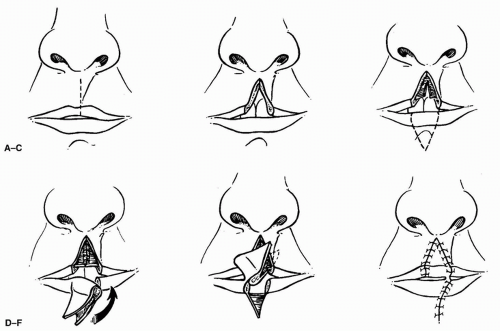Lower-Lip Sandwich Abé Skin Flap to Upper Lip
I. T. JACKSON
EDITORIAL COMMENT
The results that the author shows are outstanding. We wonder whether contraction of the upper lip also occurs when a small Abbé flap is transferred to the upper lip and the orbicularis is sutured to the Abbé flap on either side.
The aim of the cross-lip operation is to improve the appearance of the lip by releasing the tightness, establishing lip balance, and restoring the cupid’s bow. In addition, the function of the upper lip should not be compromised; ideally, it should be improved.
INDICATIONS
If there has been a poor primary lip repair with sacrifice of much tissue, the upper lip is tight. This condition can vary
from being slight and acceptable to severe, with gross lip imbalance and an unacceptable deformity. There may be central shortness with a whistling deformity and incisor show. The lip imbalance is accentuated by redundancy of the lower lip and, in some cases, maxillary retrusion. This condition is due entirely to skin sacrifice and not to muscle deficiency.
from being slight and acceptable to severe, with gross lip imbalance and an unacceptable deformity. There may be central shortness with a whistling deformity and incisor show. The lip imbalance is accentuated by redundancy of the lower lip and, in some cases, maxillary retrusion. This condition is due entirely to skin sacrifice and not to muscle deficiency.
To achieve good upper lip function, orbicularis continuity is essential. A lip may be aesthetically acceptable at rest but not when functioning if that continuity is not established. From personal experience, and according to the literature, it has been noted that the prolabium has no muscle fibers in the complete bilateral cleft. Similarly, in the unilateral cleft, the orbicularis is abnormally inserted (1, 2). If the muscle is not correctly dissected out and reconstructed, the coordinated upper lip function is poor.
In severely mutilated lips requiring a cross-lip flap, one can be sure that the level of sophistication in the original repair was low, and it is unlikely that any muscle reconstruction was performed. That being so, the orbicularis is probably intact and can be used to reconstruct muscular continuity in the upper lip. The requirements for cover of the reconstructed muscle are skin, vermilion, and mucosa; this is the sandwich cross-lip flap (3).
In the past, cross-lip flaps were lifeless curtains that moved in a secondary fashion when the lateral segments moved. The sandwich cross-lip flap is a functional flap, allowing one to sidestep the question of function in cross-lip flaps, which has its proponents (4, 5) and its antagonists (6, 7). Other advantages of this procedure are early pedicle division, a clinical impression of an improved lower lip scar, and the flexibility of having the mucosa and the skin separated, allowing for variation in design in the two layers.
Stay updated, free articles. Join our Telegram channel

Full access? Get Clinical Tree









